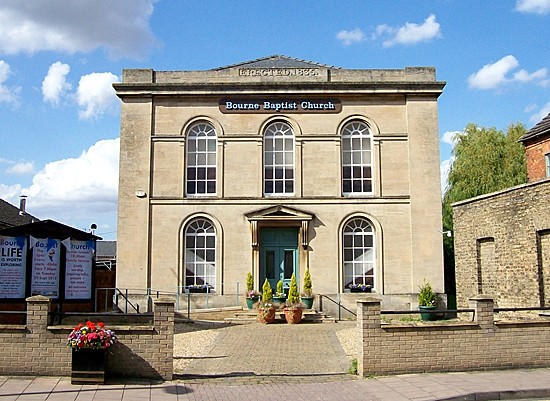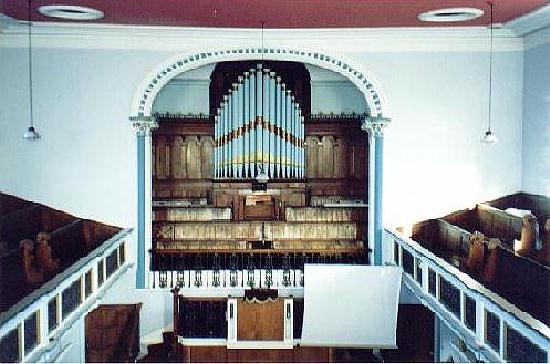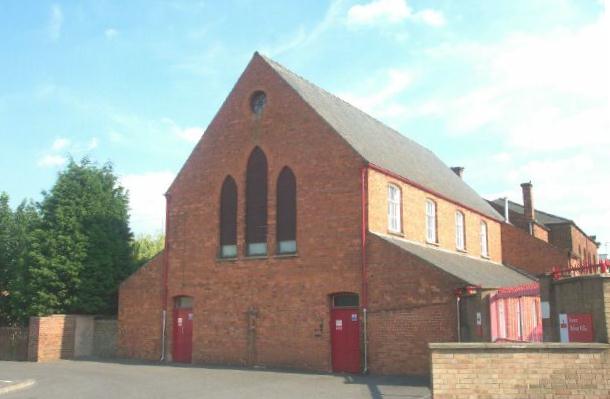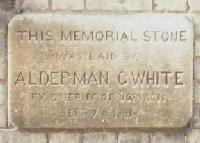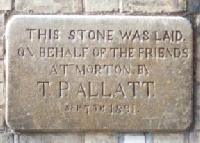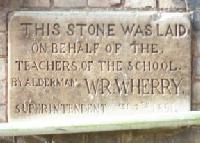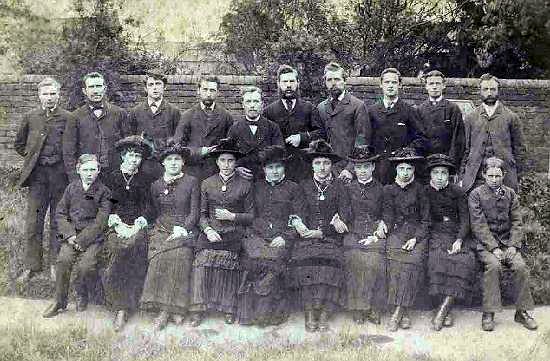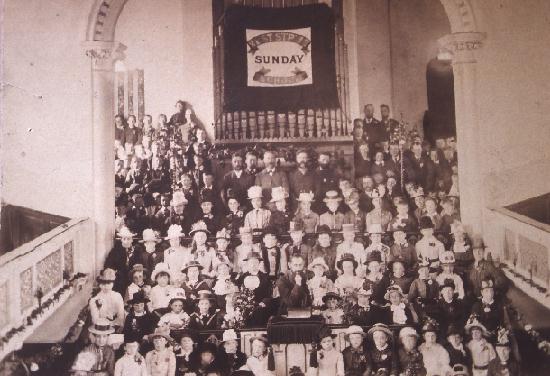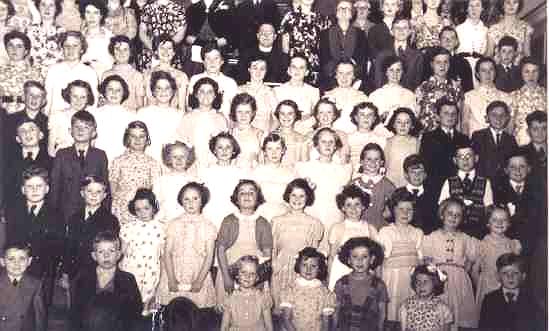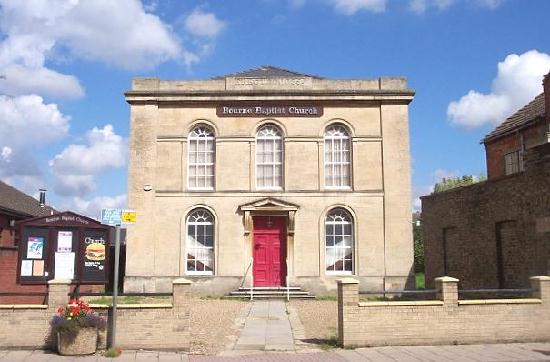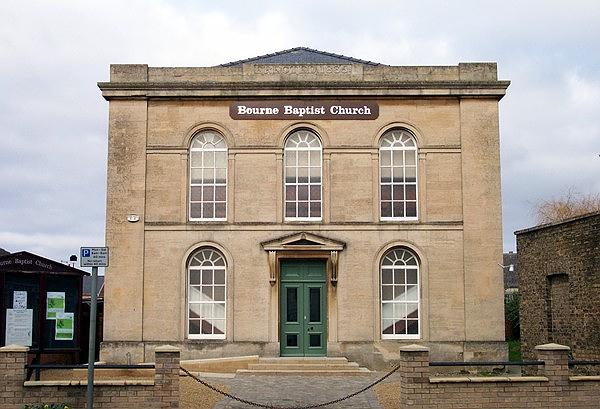|
The Baptist Church
The origins
of the Baptist Church in Bourne date
back to the Civil War of 1642-49, the armed conflict between royalist and
parliamentary forces arising from constitutional differences between
Charles I and the Long Parliament. The old castle near St Peter's Pool is
reputed to have been besieged by Cromwell's troops and a garrison
established in the vicinity and the local belief is that many of these
soldiers were Baptists and other non-conformists and attended meetings in
the houses and barns of those with a similar faith living in the locality.
Bourne Baptists therefore accept the date of 1645 as their founding year
and celebrate accordingly, particularly in November 1995 when this was
their 350th anniversary. Such meetings were banned by law but continued in private places, including the woods and the fields, but by 1689, the legislation had been relaxed and Baptists were allowed to worship as they pleased. In 1717, meetings, prayers and bible study began at a house in West Street owned by Robert Ives senior, who eventually sold the property for the use of baptised believers in the town and district. The money was provided by four gentlemen, Robert Ives senior, Robert Ives junior, Robert Arnold and William Hussey, who each contributed £19, which together with a further £10 donated by John Richardson of Aslackby, enabled them to not only purchase the land and property but also to build a new meeting house. It was small and constructed of materials contributed by the members themselves, some of them giving wood worked with their own hands, others providing stone and mortar, much of it carried to the site by friends from Haconby. The expenses for the building work were supplemented with another £5 each from eight other members. By
1831, church membership had increased to 119 with 230 children attending
Sunday School and it became apparent that a new building was needed. A
church meeting was held in 1835 when 44 members pledged a total of £212
for the project to get underway. Voluntary labour was
necessary because the church had no capital and the previous year, the
treasurer presented the accounts showing a credit balance of only one
shilling (5p in today's decimal currency). But this parlous state of their
finances did not deter members from proceeding with the project and the
first stone of the new chapel was laid on 6th May 1835 with the prayer:
"May this home be a blessing to many generations".
The total cost of the church was eventually £1,700 and it was built with an attractive frontage and a low slate roof set behind a modish parapet and the foundation stone was laid by one of the deacons, Mr Edward Wherry, a grocer from Edenham who had established a new retail business in North Street. This was an appropriate choice because members of his family subsequently served in the Baptist congregation as deacons for over a hundred years. Extra galleries were erected in 1868 and a new organ, organ gallery and vestries were added in February 1876. The organ was built by Mr Nicholson of Lincoln and was the gift of Mr George Bettinson, of Dyke. The Rev Giles Hester, of Sheffield, preached at the opening and there was a public tea followed by an organ recital given by Mr Hopkins, of Grantham, consisting of selections from Handel, Best and Beethoven. The collection to help with the costs amounted to £18. The church was originally lit by gas lamps but electric lighting was installed in 1932 at a cost of £97 6s. 9d. which was paid by an anonymous benefactor, although the schoolroom was not wired until 1936. The Baptists were also the first non-conformists to provide a Sunday School in Bourne. Classes began in 1803 and by 1924, some 5,000 children had attended. The former meeting house was converted for use as a school but was eventually pulled down in 1891 to make way for the present Sunday School premises that are still in use but now called Covenanters, beginning with toddlers through to young people aged 15 and over. The foundation stones of the new Sunday School were laid on Monday 7th September 1891 when the cost of the building was estimated at £1,100 and this included an early form of central heating which was referred to as "the warming apparatus". The Stamford Mercury reported: After a prayer by the Rev T Barras, and a few remarks by Mr Wherry, the ex-Sheriff of Norwich, Alderman George White who is a native of Bourne [later Sir George White MP], spread the mortar and laid the stone, receiving a silver trowel from the architect, Mr F G Shilcock, and contributed a cheque for £20. The second stone was laid by Alderman Wherry, his two sons assisting, and a sealed bottle containing a newspaper, a history of the school and a list of the scholars and teachers now attending, signed principally by themselves, was deposited in a cavity prepared for it. Mr T R Allatt, on behalf of the friends at Morton, laid the third memorial stone, placing thereon a contribution from the people of Morton; and at his request, Miss Wherry also assisted in the laying of the stone. Amongst the amounts placed on the stones was a cheque for £10 from Mr Coleman of Norwich, who had been invited to attend; Mr F G Shilcock £5; Mr J T Swift £10; Mr Pearce and family £11 11s.; Mrs Stubbs £5; the Rev G H Bennett, a promise to give or get £5 5s.; and numerous small sums, a number of school children also coming up with their contributions. Afterwards, a well-attended public tea was held and later in the evening, a public meeting was arranged.
The chapel was badly damaged on the afternoon of Wednesday 30th June 1897 when a fire which broke out in an adjoining workshop spread to the building. The Stamford Mercury reported: The blaze began at about 1.45 pm in the workshop in West Street of Mr Alfred Stubley, scenic artist, painter and plumber. As the building is a lofty wooden structure containing much inflammable material, the flames spread with alarming rapidity. The greater portion of Mr Stubley's valuable scenery was stored in a building adjoining but unfortunately what was in his workshop was destroyed. The roof fell in with a resounding crash. Immediately the outbreak was discovered, the Bourne Fire Brigade were summoned and they were speedily on the spot rendering effectual efforts to combat the destructive process of the flames. The western windows of the Baptist chapel nearby had caught fire and were soon burning fiercely. One of the helpers, Mr Razor, had his arm severely injured by the glass from one of these falling windows. The chapel is a beautiful and commodious building and it has only recently been renovated at considerable cost. Efforts were concentrated towards saving the fabric from threatened destruction and by the united aid of the brigade and a host of willing helpers, the danger was ultimately averted. A large crowd of spectators thronged the street. The flames were got under effectually by 3 pm. Great vigilance was still exercised in case of another outburst. The interior of the chapel was pitiable, it having been deluged with water in the work of saving the building. The western wall, with its gaping window openings, looked like a dismal ruin. Two cottages in an orchard nearby, belonging to the Marquis of Exeter, caught fire and the doors, walls and bed were charred. The timely efforts of the brigade and voluntary helpers however, prevented further destruction in this direction. The vegetation in the gardens was hopelessly charred and the apples and plums on the orchard trees roasted. We understand that the buildings are insured. It is said that the fire originated in a lighted match being thrown on some straw by a two-year-old child. During the Second World War of 1939-45, the schoolroom was taken over by Kesteven County Education Authority in 1940 in order to create additional classroom space for the town which was providing homes for dozens of evacuees, mainly from the Hull area of Yorkshire. The authority paid an annual rental of £10 plus rates, heating and lighting costs and the wages of a caretaker. The threat of air raids meant that all windows were blacked out to prevent lights from showing after dark and a blast screen was erected in front of the two main windows in the schoolroom.
A major refurbishment scheme was
undertaken towards the end of 2005 and completed in January the following
year, the biggest project of its kind in over a century. The work was
extensive and included a new floor and heating system, carpets and
redecorating, the replacement of pews with upholstered chairs, a renovated
baptistery, repairs to the roof, windows and frames, a new entrance foyer,
disabled access and paved frontage. Cars were also banned from using the
forecourt enabling the Regency frontage to be seen at all times. The total
cost was £110,000 and the minister, the Rev Derek Baines, said: “The money
was raised by friends and members of the church simply by extra giving
without the need for any fund raising events.”
In 1968, the Baptist Union was bequeathed a house at 5 Kingsway, Bourne, for the use of retired ministers and their families by Miss Lucy Ellen Story of 66 West Street, Bourne, who died on 6th March that year leaving £20,962. In her will, Miss Story asked for the house to be named and dedicated in memory of her great-aunt Jane Redmile "who did and gave so much to make it possible for people to worship as they wished". She also left £500 for the upkeep of the property and a further £2,000 to be paid to the Rev and Mrs William G M Jones of Bourne, and the survivor of them for life, and then for the assistance of any retired Baptist minister, formerly of Bourne Baptist Church. The residue of her estate was left to Bourne United Charities, the income to be given to necessitous, old, infirm or sick residents of the town.
REVISED APRIL 2013 See also The Rev James Carvath William Bampton Thomas Deacon The Rev Derek Baines Dyke Chapel
Go to: Main Index Villages Index |
||||||||||||||||||||||||||||||||||||
